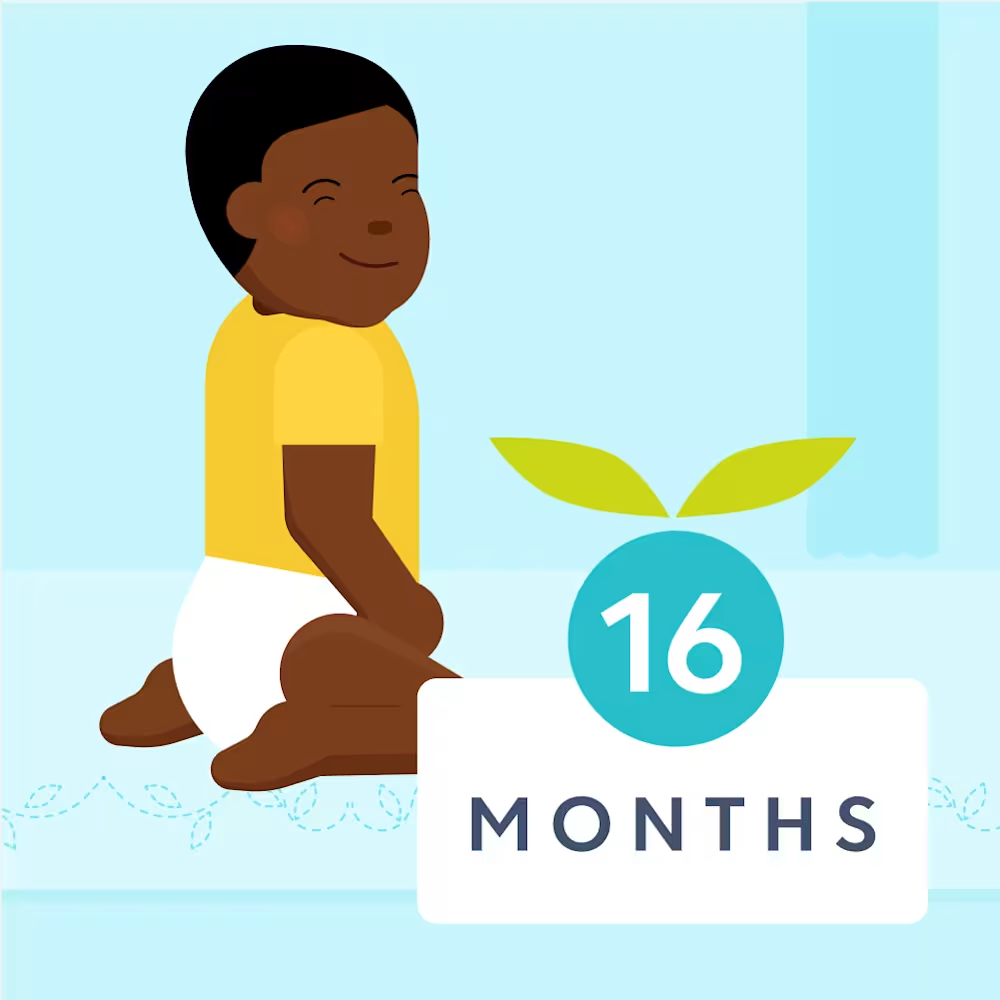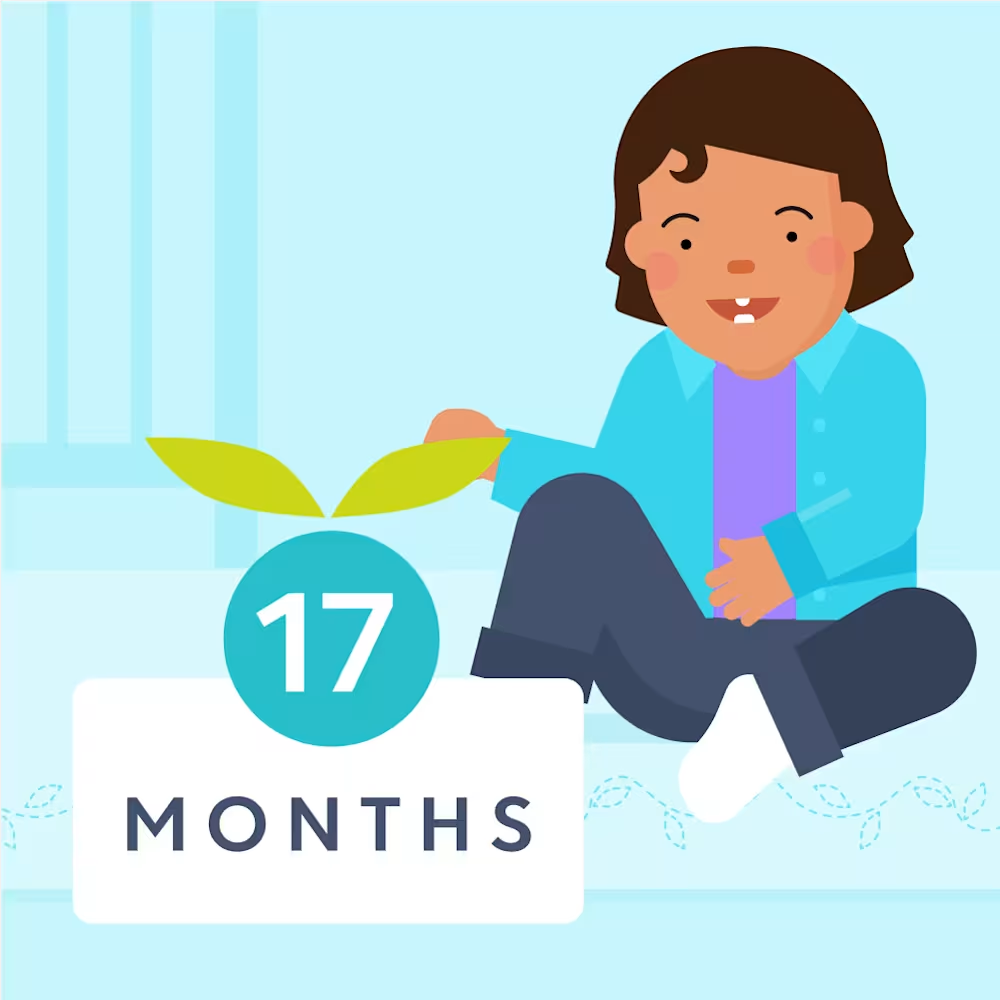16 month sleep regression: Myth or real?
Updated Dec 16, 2025

Whether sleep for your little one has been bumpy from the start or your 16 month old is suddenly dealing with some new sleep challenges, toddler sleep can be tricky at times. It’s not uncommon for kiddos to experience periods of rocky sleep during their second year as sleep patterns change and schedules shift. Although not every toddler will go through a “16 month sleep regression,” we’re here to help if your little one’s sleep has fallen off a cliff.
In this article, we’ll guide you through how to help you understand potential sleep struggles at 16 months, share tips on how to get your toddler’s sleep back on track, and answer frequently asked questions about sleep at this age.
Table of Contents
Is there a 16 month old sleep regression?
There isn’t a set 16 month old sleep regression that all children face. Every toddler is different! Instead, sleep patterns tend to ebb and flow as kiddos grow. However, it’s not uncommon for toddlers who are sleeping well to experience an onset of sleep challenges around this age. This period of bumpy nights or naps may include a range of sleep disturbances from an increase in night wakings to a kiddo who suddenly resists sleep altogether. If your little one is suddenly facing new sleep struggles during the day and/or night, we’d consider this a sleep regression.
Why do 16 month old toddlers have sleep issues?
Reason #1: They need help falling asleep
One of the main reasons a little one struggles with naps or frequent night wakings is that they rely on an adult to help them fall asleep. There’s nothing wrong with comforting a child at bedtime and we always encourage comfort and connection during the bedtime routine. However, if a child becomes accustomed to receiving parental help to fall asleep, they often rely on this support and protest if it’s taken away. We call this a sleep onset association.
Common include feeding, using a rocking motion, and holding or patting a child to sleep. They can lead to disrupted sleep because if a child wakes up during the night or during a nap, it may be challenging to fall back to sleep without you. They may depend on that same comfort in the middle of the night or after a short nap.
Reason #2: Their sleep needs are changing
Many toddlers drop from a between 14 - 18 months old. Even if your little one has outgrown their second nap, the transition doesn’t typically happen overnight — and can bring a period of fragmented sleep with it. When your 16 month old is ready to drop a nap, they may resist daytime sleep, take shorter than usual naps, or skip them entirely. They may also suddenly start waking early, have split nights (when they are awake for long periods in the middle of the night), or regularly get less than 10 hours of sleep per night.
As toddlers transition to longer stretches of awake time, it may take them a few weeks to adjust. During this time, it’s also common for little ones to become overtired by bedtime, making it harder for them to fall asleep and stay asleep.
Reason #3: They’re teething
Teething pain may like night waking, sleep resistance, and fussiness. If your little one is uncomfortable due to new chompers breaking through, the pain may make it harder to sleep, waking them after just 10 - 20 minutes of shuteye instead of in between 50-minute sleep cycles. In addition to discomfort, teething can also be accompanied by gum swelling/tenderness, refusal to eat (which may also lead to night wakings from hunger), increased drooling, biting, and chewing.
Reason #4: They’re going through separation anxiety
Between 15 - 18 months [], many toddlers experience separation anxiety. It’s a normal part of healthy child development for little ones to be extra clingy when separating from a caregiver at this age []. However, the distress many kiddos feel while away from their parents during this phase may contribute to sleep challenges when it’s time to settle down and say goodnight.
How long does a 16 month sleep regression last?
Since there’s no predetermined 16 month sleep regression, there’s no scheduled start and stop date either. Instead, toddlers between 14 - 18 months commonly experience periods of rocky sleep (sometimes referred to as the “”) for a variety of reasons. Some toddlers may never be impacted, and for those who are, the duration depends on the root cause, as well as the steps taken to improve sleep.
For example, if your little one has a sudden increase in night wakings because of teething pain, they may start sleeping better again faster than a child who’s resisting sleep due to ongoing separation anxiety.
My 16 month old won’t nap. Does 16 month regression affect naps?
Sleep may be bumpy during the day and night for toddlers. If your little one starts fighting naps, taking shorter ones, or skipping them altogether, they may be ready for longer wake windows and/or to drop a nap. A schedule adjustment can help get daytime sleep back on track, but this transition may take a few weeks.
Also, keep in mind that an onset of daytime sleep struggles doesn’t automatically mean your is ready for a 1-nap schedule. Other factors may also be behind the sudden nap challenges including naptime routines, sleep associations, separation anxiety, and teething.
If you’re feeling stuck and want more help with your toddler’s sleep, we can help! With, you can submit for a personalized, step-by-step Sleep Plan for your child.
4 tips to handle 16 month old sleep issues or regressions
Tip | Why it helps | What to try |
|---|---|---|
Work on independent sleep skills. | Toddlers who can fall asleep on their own typically sleep longer and wake less overnight. | If your child needs rocking, feeding, or holding to fall asleep, gradually reduce the support. Consider gentle sleep training or a personalized plan. |
Adjust your schedule — and expectations. | Dropping a nap is often rocky for a bit. Overtiredness can lead to skipped naps, early wakings, and bedtime battles. | Expect nap limbo for a few weeks. Offer earlier bedtimes as needed (but not before 6 PM) on skipped or short nap days. Once on one nap, keep wake windows longer. |
Aim to keep bedtime routines consistent. | Predictable routines help toddlers shift from play mode to sleep mode, even during regressions. | Stick to your typical routine each night to maintain cues that it’s time for sleep, even when days feel rocky. |
Account for extra wind-down time (and reassurance). | Toddlers need more time to settle and may experience stronger separation anxiety at this age. | Add extra calm time, dim lights, and plenty of connection before saying goodnight. Offer reassurance but hold boundaries. |
Find more details below:
Tip #1: Work on independent sleep skills
When it comes to sleep, we support families doing what works best for them and their children (as long as it’s safe). However, if your little one struggles with sleep, including frequent night wakings, and you’re looking to make a change, a helpful first step is often evaluating how they’re falling asleep. Children who need help from their parents to fall asleep at night tend to have more sleep challenges [] and less overall sleep.
Instead of physically helping your toddler fall asleep, consider helping them learn to fall asleep without being rocked, fed, held, or otherwise helped. One of the ways you can do this is through sleep training. (You can learn about the.) If you’re looking for personalized guidance, consider.
Tip #2: Adjust your schedule — and expectations
When toddlers are ready to drop a nap, it’s often done gradually and may take a couple of weeks of nap limbo — meaning they’ll take one nap some days and two naps others. Shorter and skipped naps are also common during nap transitions, making it easier for kiddos to become overtired. This, in turn, may make falling asleep and staying asleep more difficult, so they may also need an earlier bedtime on some days to help limit overtiredness.
From not knowing what kind of nap day it will be to navigating shifting bedtimes, this can also be a tricky time for parents. While frustrating, keep in mind this is a phase and after a few weeks most little ones will settle into a new sleep schedule. However, once your toddler settles into a consistent 1-nap schedule with longer wake windows, they may consistently require an early bedtime to prevent overtiredness. For some families, this may mean a new bedtime closer to 6:00 PM. However, once little ones get accustomed to staying awake for longer periods, bedtimes may be able to shift back later.
Tip #3: Aim to keep bedtime routines consistent
During periods of rocky sleep, it may be tempting to deviate from normal bedtime routines. However, we find it’s helpful to stick to your usual bedtime routine as much as possible for consistency and to signal to your child that it’s time for sleep. Straying too far from your typical pre-sleep ritual, even just for a few nights, may lead to additional sleep difficulties [].
Tip #4: Account for some extra wind-down time (and reassurance)
Although it’s beneficial to keep your toddler’s pre-sleep rituals consistent, it can be helpful to add in some extra wind-down time before bed at this age, especially during periods of poor sleep. As toddlers get older not only do their last wake windows lengthen, but also they need more time in their pre-sleep routine to transition from playtime to bedtime. Plus, if they’re going through a bout of separation anxiety, it may be harder for them to part ways with their caregiver at night. For these kiddos, extra reassurance, cuddles, and time with their parents before saying goodnight may help them get better rest.
How much sleep does a 16 month old need?
, most toddlers need around 13 - 14 hours of total sleep over 24 hours. This typically breaks down to about 10 - 12 hours of nighttime sleep and 2 - 3 hours of daytime sleep, split between 1 or 2 naps. Most children make the between 14 - 18 months.
However, if your little one is sleeping more or less than this, that’s OK too. These are general guidelines, not hard and fast rules. Some children have higher or lower sleep needs and that’s normal. Evaluate your child’s overall mood and energy levels when determining if they’re getting the shuteye they need.
How can I tell if it's separation anxiety or 16 month sleep problems?
Separation anxiety can still show up around 16 months, even though many toddlers are gaining confidence with short separations. Your child understands that you leave and return, but emotions can still run high, especially at bedtime.
Separation at bedtime may feel harder and contribute to sleep challenges like resisting bedtime or waking more overnight. Offer reassurance, keep routines predictable, and remember this phase is a normal part of emotional development.
How can I tell if it's teething or 16 month sleep problems?
At 16 months, toddlers may still be teething, including painful molars. Teething at this age can cause discomfort, fussiness, and increased night waking — so it’s not always teething or sleep problems. Extra comfort before bed and consistent routines can help support sleep during this time.
Can you sleep train during a sleep regression?
Yes, is an option at 16 months, even during periods of rocky sleep. Teaching your child independent sleep habits can help improve sleep quality and reduce night wakings — for your toddler and you. The key is choosing a method that works with your child’s temperament and your parenting preferences. Some options include gradual methods (e.g. Fading) that may take a few weeks (or longer) to be effective and others (e.g. Ferber) tend to work faster but may produce more tears in the short term.
Can I let my 16 month old cry it out during a sleep regression?
Yes, you can use a “” (CIO) or extinction method for your 16 month old during a sleep regression. This may be effective if check-ins associated with other techniques like check and console (e.g. the method) tend to upset your child. Before starting CIO, ensure your child is fed, dry, and safe before putting them down. We recommend using a video baby monitor as well. You might also consider methods like fading, which can teach self-soothing skills while offering more support along the way. These approaches typically take longer — sometimes a few weeks or more — but can be useful for families who prefer to make gradual changes. Trust your instincts and adjust as needed.
What are self-care tips for tired parents?
Follow the 80/20 rule: Working your schedule around your child’s sleep can be tricky at this age, especially if they’re in the midst of the 2-to-1 nap transition and you have no idea what kind of day it will be. Will your child skip their second nap and need to go to bed early? Or will they take the second nap and stay up “late”? It’s typically anyone’s guess each day. To help navigate this limbo time, try following the 80/20 rule. 80% of the time you lean into their sleep schedule while the other 20% of the time you’re a bit more flexible. This may look like risking a meltdown to keep dinner plans even if they don’t nap or intentionally do something during the day instead of coming home for a (possible) nap.
Take one thing off your to-do list: Does it feel like your list of things to get done in a day is a mile long? Try axing an item from your list — without the guilt. Sometimes giving yourself permission to abandon a chore can be refreshing and reduce your mental load. You can always re-add it later.
Get outside: Fresh air can help make even the hardest days a little more manageable. Whenever possible, give yourself (and your kiddo) a reset by stepping outdoors. Take a walk around the block, play in the backyard, or help your toddler collect leaves!
Should I let my baby sleep in my bed during a regression?
The American Academy of Pediatrics (AAP) advises against bedsharing during the first year of your child’s life to reduce the risk of SIDS []. For babies over 12 months, the guidance is less specific, though the AAP still doesn’t formally endorse bringing your child into bed. However, the risk of SIDS drops a lot after a year.
Many families choose to bedshare at this age, especially during periods of rocky sleep. If you bring your child into bed, aim to keep things as safe as possible. Also be mindful of safety concerns like falls, suffocation, and entrapment. Some safety best practices include:
Keep pillows and heavy blankets away from your child
Use a firm mattress
Avoid sharing the bed with anyone under the influence of substances that affect alertness
When to talk to a doctor
Bouts of poor sleep are very common, even in the toddler years. Usually, these phases are normal and nothing to be worry about. That said, there are times when your child’s sleep patterns might feel concerning. If you’re ever unsure, it’s always okay to check in with your pediatrician.
Here are some instances where you might consider checking in with your child’s doctor:
Feeding or weight gain concerns: Consistently skipping meals, not gaining weight as expected (though growth slows down in your baby’s second year)
Persistent fussiness: Signs of pain, extra hard to soothe
Unusual symptoms: Vomiting, a lingering cough, fever, rash etc.
Unusual sleepiness: Overly drowsy, hard to wake
Other red flags: Reach out to their healthcare provider if something feels off. It’s often better to err on the side of caution in these instances.
Takeaway
Sleep regressions are a normal part of development that can happen at any age.
Toddlers around 16 months may experience sleep challenges due to various factors, including needing help to fall asleep, being ready for longer wake windows, teething, and going through separation anxiety.
How long these sleep challenges stick around depends on their root cause — and the steps taken to alleviate them.
16 month sleep regression FAQ
Share article:
Note: The content on this site is for informational purposes only and should not replace medical advice from your doctor, pediatrician, or medical professional. If you have questions or concerns, you should contact a medical professional.
6 Sources
Table of Contents
Share article:





